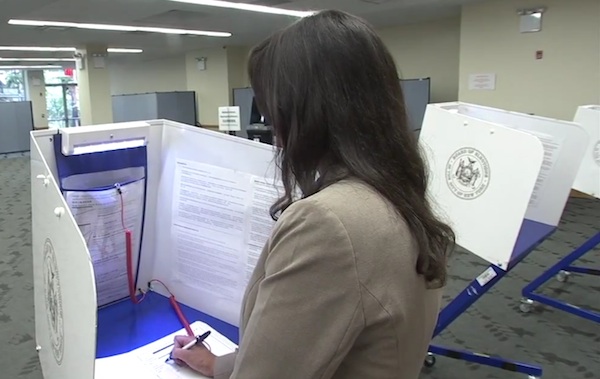
Photo by: NYC BOE
In a scene from a Board of Elections instructional video, a voter uses the “privacy booth” that’s now part of New York City’s electoral machinery.
While many people in Morris Park will be following the race between Naomi Rivera and Mark Gjonaj for the 80th District Assembly seat, others will be watching the voting machines.
In 2010, a new voting mechanism was implemented statewide. Instead of using lever machines, voters filled out paper ballots and inserted them into optical scan machines. Throughout the city, the new machines either malfunctioned, or confused voters with jargon-laden language, resulting in overvotes. This is when a vote is counted twice, and therefore discounted.
According to the Brennan Center, a voter and legal advocacy group at the New York University School of Law, the city lost about 6,500 votes in the governor’s race, and 20,000 in all the races. Overall, the state lost about 60,000 votes in all the races. This was the first time in New York’s history that so many votes were lost.
In New York City, the Bronx had the highest overvote rate at 31.9 percent. Morris Park had at least a 10 percent overvote rate in the 2010 governor’s race, one of the highest rates in the city.
The citywide overvote issue raised enough concern that the Brennan Center released a 42-page report on the topic and launched an investigation focusing on P.S 65 in the South Bronx, which had an overvote rate of up to 40 percent. Anthony Ribustello, a deputy clerk at the Bronx Board of Elections, said this was the only polling place in the Bronx where the overvote was a result of machine malfunction. He said he wasn’t aware of the malfunction until the report was released.
Following the Brennan Center report, the machine was tested, but the test was inconclusive as to what caused the overvote, Ribustello said. “It could’ve been a result of cleaning it,” he added. The machine has since been replaced.
Ribustello said the overvote in Morris Park was voter-related, and not a result of the machines malfunctioning. “Sometimes the voters read the ballots incorrectly,” he said. “Sometimes they either vote for everyone or no one because of voter protest.”
Larry Norden, a deputy director at the Brennan Center, said it was hard to know what happened, but the overvote in Morris Park was likely a combination of machine and voter error. “It could’ve been voter education problems, or voters were confused by the ballot,” he said.
As for the upcoming election in Morris Park, Ribustello said the error message voters would get if a ballot is overvoted has been updated from “The following contests on the ballot are overvoted” to a more user-friendly message, although he didn’t recall the exact message.
Ribustello is confident that the machines will function properly on Nov. 6, although neither the Board of Elections nor the Brennan Center will be monitoring the situation.
“We will swap the machine out if it’s reporting a problem,” Ribustello said.
Norden said there would be notices at polling places about overvoting. “One thing people should look out for is an error message from the machine, and ask a poll worker for help if they don’t understand it.”
However, whether or not overvoting occurs in Morris Park, and citywide, won’t be known until after the election data is in, Norden said.








